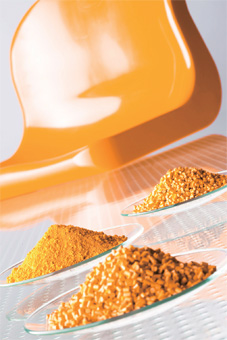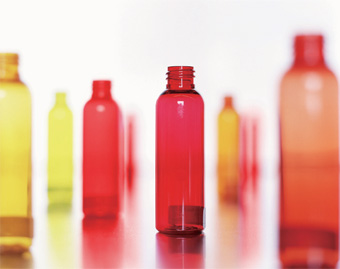
Brilliant, colourful products have become the trend in today's rapidly evolving consumer market. A product's colour has increasingly become an additional factor to generate market attention. This brings into focus the innovative and broad spectrum of dyes for the colouring of plastic products. Particularly in plastics processing technology, there is a demand for not only colour intensity and brilliance but also for a number of other properties, one example being temperature resistance. There is also the challenge of achieving certain colour shade and intensity, for example for red and orange colours.
Alternative to red dyes containing halogen Chemicals group LANXESS launched its organic dyes for the colouring of a range of plastic products. Its Macrolex Gran is considered an industry-leading technology that can be felt and seen through a bunch of brilliantly colourful PET bottles, a key application of Macrolex Gran. Macrolex Gran serves as a stepping stone in plastic colourants. As a pioneer microgranule dye, it features major advantages such as high efficiency, lower cost and easy processing. Macrolex colourants are used in applications with stringent purity requirements, including the colouration of food packaging such as PET bottles and for children's toys. Macrolex dyes are also compatible with the requirements of the U.S. Food and Drug Administration (FDA). The dyes are available in a number of forms, including microgranules. These hollow spheres can be easily compressed and quickly, evenly and completely distributed and incorporated into the plastic. Their good flowability brings with it a number of advantages: They do not clump, can be precisely metered and can be completely emptied from containers. The products are ideally suited for the colouration of amorphous polymers such as PS, PC, ABS, PMMA and PET. Thus, Macrolex dyes provide reliable and cost-effective solutions to customers in the fast growing beverage packaging industry while helping to address environmental concerns. Lightweight and recyclable, the colourful PET bottle is an environmentally friendly packaging solution for the beverage industry, replacing heavier and more fragile glass bottles and high-cost aluminium cans. Recently, LANXESS responded to increasing market demand for halogen-free red dyes with its newly launched Macrolex Red A - a particularly high-tinting-strength and brilliant alternative to common, halogen-bearing products with a colour index of Solvent Red 135 (S.R. 135). Macrolex Red A is a soluble, organic dye suitable for use in many amorphous and semi-crystalline engineering plastics. Like the other members of the Macrolex family, it is characterised by high thermal and light stability and good weatherability.

For many plastics processors Macrolex Red A is becoming an increasingly attractive halogen-free alternative to common dyes containing halogen such as halogenated perinones like S.R. 135. Unlike those, Macrolex Red A contains no halogens in its chemical structure, yet features a similar red shade with a yellow undertone and is therefore a suitable replacement in many colour formulations for products with the colour index Solvent Red 135. Compared to this dye, Macrolex Red A exhibits better solubility in many polymers, which makes processing significantly easier, and can also prevent coloured stippling in the product. Coloured master batches can also have higher dye concentrations, which significantly boost productivity during their production. Furthermore, the tinting strength of Macrolex Red A is roughly 3.5 times greater than that of S.R. 135 containing halogen.
Reinventing orange When it comes to engine e r ing plastics for use in demanding applications, however, useful orange pigments are few and far between. Sicopal® Orange K 2430 from BASF is a new, extraordi
Nike KD Brilliant, colourful products have become the trend in today's rapidly evolving consumer market. A product's colour has increasingly become an additional factor to generate market attention. This brings into focus the innovative and broad spectrum of dyes for the colouring of plastic products. Particularly in plastics processing technology, there is a demand for not only colour intensity and brilliance but also for a number of other properties, one example being temperature resistance. There is also the challenge of achieving certain colour shade and intensity, for example for red and orange colours. Alternative to red dyes containing halogen Chemicals group LANXESS launched its organic dyes for the colouring of a range of plastic products. Its Macrolex Gran is considered an industry-leading technology that can be felt and seen through a bunch of brilliantly colourful PET bottles, a key application of Macrolex Gran. Macrolex Gran serves as a stepping stone in plastic colourants. As a pioneer microgranule dye, it features major advantages such as high efficiency, lower cost and easy processing. Macrolex colourants are used in applications with stringent purity requirements, including the colouration of food packaging such as PET bottles and for children's toys. Macrolex dyes are also compatible with the requirements of the U.S. Food and Drug Administration (FDA). The dyes are available in a number of forms, including microgranules. These hollow spheres can be easily compressed and quickly, evenly and completely distributed and incorporated into the plastic. Their good flowability brings with it a number of advantages: They do not clump, can be precisely metered and can be completely emptied from containers. The products are ideally suited for the colouration of amorphous polymers such as PS, PC, ABS, PMMA and PET. Thus, Macrolex dyes provide reliable and cost-effective solutions to customers in the fast growing beverage packaging industry while helping to address environmental concerns. Lightweight and recyclable, the colourful PET bottle is an environmentally friendly packaging solution for the beverage industry, replacing heavier and more fragile glass bottles and high-cost aluminium cans. Recently, LANXESS responded to increasing market demand for halogen-free red dyes with its newly launched Macrolex Red A - a particularly high-tinting-strength and brilliant alternative to common, halogen-bearing products with a colour index of Solvent Red 135 (S.R. 135). Macrolex Red A is a soluble, organic dye suitable for use in many amorphous and semi-crystalline engineering plastics. Like the other members of the Macrolex family, it is characterised by high thermal and light stability and good weatherability.
Brilliant, colourful products have become the trend in today's rapidly evolving consumer market. A product's colour has increasingly become an additional factor to generate market attention. This brings into focus the innovative and broad spectrum of dyes for the colouring of plastic products. Particularly in plastics processing technology, there is a demand for not only colour intensity and brilliance but also for a number of other properties, one example being temperature resistance. There is also the challenge of achieving certain colour shade and intensity, for example for red and orange colours. Alternative to red dyes containing halogen Chemicals group LANXESS launched its organic dyes for the colouring of a range of plastic products. Its Macrolex Gran is considered an industry-leading technology that can be felt and seen through a bunch of brilliantly colourful PET bottles, a key application of Macrolex Gran. Macrolex Gran serves as a stepping stone in plastic colourants. As a pioneer microgranule dye, it features major advantages such as high efficiency, lower cost and easy processing. Macrolex colourants are used in applications with stringent purity requirements, including the colouration of food packaging such as PET bottles and for children's toys. Macrolex dyes are also compatible with the requirements of the U.S. Food and Drug Administration (FDA). The dyes are available in a number of forms, including microgranules. These hollow spheres can be easily compressed and quickly, evenly and completely distributed and incorporated into the plastic. Their good flowability brings with it a number of advantages: They do not clump, can be precisely metered and can be completely emptied from containers. The products are ideally suited for the colouration of amorphous polymers such as PS, PC, ABS, PMMA and PET. Thus, Macrolex dyes provide reliable and cost-effective solutions to customers in the fast growing beverage packaging industry while helping to address environmental concerns. Lightweight and recyclable, the colourful PET bottle is an environmentally friendly packaging solution for the beverage industry, replacing heavier and more fragile glass bottles and high-cost aluminium cans. Recently, LANXESS responded to increasing market demand for halogen-free red dyes with its newly launched Macrolex Red A - a particularly high-tinting-strength and brilliant alternative to common, halogen-bearing products with a colour index of Solvent Red 135 (S.R. 135). Macrolex Red A is a soluble, organic dye suitable for use in many amorphous and semi-crystalline engineering plastics. Like the other members of the Macrolex family, it is characterised by high thermal and light stability and good weatherability.  For many plastics processors Macrolex Red A is becoming an increasingly attractive halogen-free alternative to common dyes containing halogen such as halogenated perinones like S.R. 135. Unlike those, Macrolex Red A contains no halogens in its chemical structure, yet features a similar red shade with a yellow undertone and is therefore a suitable replacement in many colour formulations for products with the colour index Solvent Red 135. Compared to this dye, Macrolex Red A exhibits better solubility in many polymers, which makes processing significantly easier, and can also prevent coloured stippling in the product. Coloured master batches can also have higher dye concentrations, which significantly boost productivity during their production. Furthermore, the tinting strength of Macrolex Red A is roughly 3.5 times greater than that of S.R. 135 containing halogen. Reinventing orange When it comes to engine e r ing plastics for use in demanding applications, however, useful orange pigments are few and far between. Sicopal® Orange K 2430 from BASF is a new, extraordiNike KD
For many plastics processors Macrolex Red A is becoming an increasingly attractive halogen-free alternative to common dyes containing halogen such as halogenated perinones like S.R. 135. Unlike those, Macrolex Red A contains no halogens in its chemical structure, yet features a similar red shade with a yellow undertone and is therefore a suitable replacement in many colour formulations for products with the colour index Solvent Red 135. Compared to this dye, Macrolex Red A exhibits better solubility in many polymers, which makes processing significantly easier, and can also prevent coloured stippling in the product. Coloured master batches can also have higher dye concentrations, which significantly boost productivity during their production. Furthermore, the tinting strength of Macrolex Red A is roughly 3.5 times greater than that of S.R. 135 containing halogen. Reinventing orange When it comes to engine e r ing plastics for use in demanding applications, however, useful orange pigments are few and far between. Sicopal® Orange K 2430 from BASF is a new, extraordiNike KD
 iConnectHub
iConnectHub
 Login/Register
Login/Register Supplier Login
Supplier Login


























